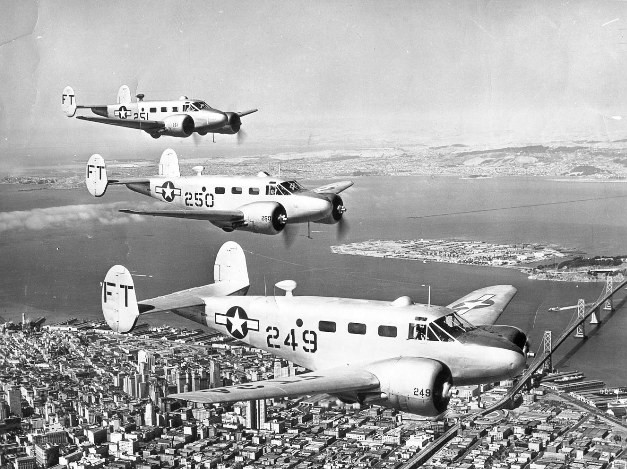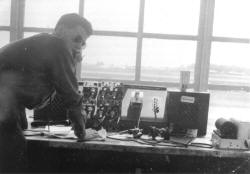WWII Radios, Photos, and Restorations



Someday I hope to expand this page into a full web site. There is so much interesting information about this subject that I wish there were more time in the day to devote to building pages. If you have any information or images that you would like to add please send it to me and I will gladly do so. The more interest and feedback that I get the more it stimulates me (by kicking me in the seat of the pants) to put more information up and to make improvements.
That said, there is not much rhyme or reason to the arrangement of this page. Things get thrown in to help answer some folks questions. Thanks for your help and patience.
What you see in this photo is a perfect example of authenticity at its best. Not only are the radios and their control heads installed but they are operational as well.
In responce to an inquiry about the mounting of the AN-104 VHF antenna I have posted the image to the left and the following two shots.
This is a photo of the radios in the back of the FHC P-47D-40. In the foreground is the APS-13 tail warning radar. Just above the APS-13 is the SCR-695 IFF set. To the right is the SCR-522 VHF command set and its dynamotor or power unit. Note the interesting antenna connector on the SCR-522.
To the right is another photo of the interior of the aft fuselage of the FHC P-47D-40. Note the induction air cleaner. The brown wood part is the AN-104 VHF antenna that was used by the SCR-522 command radio. This is an excellent antenna that can be used today as it is being used by the FHC P-47. The modern comm radio is hooked up to this antenna.
Below is a shot of the AN-104 installation in the back of a P-51D-30NA that Mike VadeBonCoeur built atMidwest Aero Restorations. Mike also has that eye for authenticity that is so rare these days.
Below is a the AN-104 antenna mounted to the top of a Beechcraft 3NM Canadian Navigation trainer.
Here is an interesting report on
the Yardeny auto tuner which is mounted on the front of an R-26 receiver of the
ARC-5. This receiver was linked to the ART-13 Liaison transmitter so the pilot
or radio operator could tune both the transmitter and the receiver together.
Click on the picture to look at the report and another shot of the radio set in
a TBM-1C Avenger. The report is a PDF file which is about 4 MB;
click here to view the
full report.
What a great photograph of an
Eighth Air Force radio technician working on an SCR-522 VHF transceiver. It
looks like this repair shack has been made from a shipping crate and isn't quite
tall enough for him to stand in. I like the twisted wire for the lights on the
ceiling of the crate/shop. Of interest is the specialized test equipment for the
SCR-522 that is mounted on the wall. A BC-347 intercom has been mocked up to be
able to listen to the audio. An MG-149 inverter is mounted underneath the bench
to supply 115 volt 400 cycle needed for certain radio gear. Four transmitters
and one receiver for the SCR-274N command set are up on the shelf to the left.
The SCR-522 was a four channel crystal controlled set designed by the British
early in the war. The set became standard equipment and was used in almost every
theatre in WWII. The set was used through the 50's and some countries were using
it into the 60's. The same frequencies, then called UHF, now are referred to VHF
are used by air traffic control and civilian aircraft today.
WWII original color photographs
certainly are impressive. This radio technician at the Consolidated Vultee
factory is performing a radio check on the SCR-274N set installed in the BT-13B.
He has the copy of the manual and the blueprint of the radio schematic on his
lap. These documents would be placed in the stowage compartment and were
delivered with this aircraft. All military aircraft in WWII carried a complete
set of technical manuals both specific to the aircraft type and to its radio
systems.
 Here the control tower at the 8th Air Force base
at Thorpe Abbotts in England. This was the home of the 100th bomb group (the
bloody 100th) that flew B-17's. It is interesting to see that the radios used in
the control tower are the same exact sets that were installed in the aircraft.
On the left, two Command sets (SCR-274N) with a transmitter control box and a
two receiver control box for each set. Just to the right of that is an intercom jack box
(BC-1366) which allows the controller to switch between the sets. The control
head for the VHF set (SCR-522) can be seen next to the intercom box. The SCR-522
was a four channel crystal controlled radio that was developed by the British
and became widely used throughout the war. Ray Robinson pointed out the BC-456
modulator for the SCR-274N sitting on the right side of the table. Thanks Ray!
Here the control tower at the 8th Air Force base
at Thorpe Abbotts in England. This was the home of the 100th bomb group (the
bloody 100th) that flew B-17's. It is interesting to see that the radios used in
the control tower are the same exact sets that were installed in the aircraft.
On the left, two Command sets (SCR-274N) with a transmitter control box and a
two receiver control box for each set. Just to the right of that is an intercom jack box
(BC-1366) which allows the controller to switch between the sets. The control
head for the VHF set (SCR-522) can be seen next to the intercom box. The SCR-522
was a four channel crystal controlled radio that was developed by the British
and became widely used throughout the war. Ray Robinson pointed out the BC-456
modulator for the SCR-274N sitting on the right side of the table. Thanks Ray!
The tower pictured above is alive and well. There is a great museum in the building below the tower and in several other buildings as well. They are trying to restore the inside of the tower just as it was in this photo.
For more information and pictures of the control tower try this link: THIS A DEAD LINK
For more information about the 100th Bomb Group, click here
The right photo shows how our GH-2 will look someday. She will be stock and original, painted in the three tone Navy colors and will be complete with all of the antenna wires that you see in the image.
Below, you will find some interesting documents that I have come across while researching radio equipment for the restoration of various WWII aircraft.
This is a document dated November 18, 1942 that details what radios should be installed into fighter aircraft in accordance with their destination.
Here is a three page document dated 11-24-42 that specifies what radio equipment will be installed in various aircraft that were slated for the 8th Air Force as of January 1, 1943. Of interest is the various configurations for the different aircraft. It is nice to find a document that gives the specific model number of the radios used in the theatre.
The following are excerpts from a memo about WWII aircraft radio production projections. It is interesting to note the differences between total requirements and total production.
Here is a great link for an awesome resource for old military radios: http://www.royalsignals.org.uk